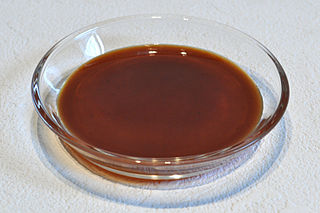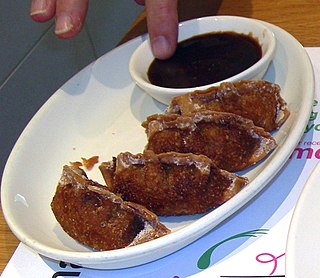
Worcestershire sauce or Worcester sauce is a fermented liquid condiment invented by pharmacists John Wheeley Lea and William Henry Perrins in the city of Worcester in Worcestershire, England, during the first half of the 19th century. The inventors went on to form the company Lea & Perrins.

Seasoning is the process of supplementing food via herbs, spices, and/or salts, intended to enhance a particular flavour.

Ketchup or catsup is a table condiment with a sweet and sour flavor. "Ketchup" now typically refers to tomato ketchup, although early recipes for various different varieties of ketchup contained mushrooms, oysters, mussels, egg whites, grapes, or walnuts, among other ingredients.

Rémoulade is a cold sauce. Although similar to tartar sauce, it is often more yellowish, sometimes flavored with curry, and often contains chopped pickles or piccalilli. It can also contain horseradish, paprika, anchovies, capers and a host of other items.

Hot sauce is a type of condiment, seasoning, or salsa made from chili peppers and other ingredients. Many commercial varieties of mass-produced hot sauce exist.

Chimichurri is an uncooked sauce used as an ingredient in cooking and as a table condiment for grilled meat. Found originally in Argentina and used in Argentinian, Uruguayan, Paraguayan and Brazilian cuisines, it has become widely adopted in most of Latin America. The sauce comes in green and red varieties. It is made of finely chopped flat leaf parsley, red fresno chili peppers, minced garlic, olive oil, oregano and vinegar or lemon juice. It is similar to Moroccan chermoula.

Plum sauce is a viscous, light-brown sweet and sour condiment. It is used in Cantonese cuisine as a dip for deep-fried dishes, such as spring rolls, noodles, deep-fried chicken balls and roast duck. It is made from sweet plums or other fruit such as peach, pineapple or apricot, along with sugar, vinegar, salt, ginger and chili peppers.

Duck sauce is a condiment with a sweet and sour flavor and a translucent orange appearance similar to a thin jelly. Offered at American Chinese restaurants, it is used as a dip for deep-fried dishes such as wonton strips, spring rolls, egg rolls, duck, chicken, fish, or with rice or noodles. It is often provided in single-serving packets along with soy sauce, mustard, hot sauce or red chili powder. It may be used as a glaze on foods, such as poultry. Despite its name, the sauce is not prepared using duck meat; rather it is named as such because it is a common accompaniment to Chinese-style duck dishes.

The generic term for condiments in the Filipino cuisine is sawsawan. Unlike sauces in other Southeast Asian regions, most sawsawan are not prepared beforehand, but are assembled on the table according to the preferences of the diner.

Clams casino is a clam "on the halfshell" dish with breadcrumbs and bacon. Green peppers are also a common ingredient.

Bumbu is the Indonesian word for a blend of spices and for pastes and it commonly appears in the names of spice mixtures, sauces and seasoning pastes. The official Indonesian language dictionary describes bumbu as "various types of herbs and plants that have a pleasant aroma and flavour — such as ginger, turmeric, galangal, nutmeg and pepper — used to enhance the flavour of the food."

Crab in Padang sauce or Padang crab is an Indonesian seafood dish of crab served in hot and spicy Padang sauce. It is one of the two most popular ways that crab is served in Indonesia, commonly found in coastal cities with abundant seafood, such as Padang, Jakarta, Medan, Surabaya, Makassar and Cirebon. Its closest analogue probably is chili crab; however, Padang crab uses richer spices.

Mushroom ketchup is a style of ketchup that is prepared with mushrooms as its primary ingredient. Originally, ketchup in the United Kingdom was prepared with mushrooms as a primary ingredient, instead of tomato, the main ingredient in most modern preparations of ketchup. Historical preparations involved packing whole mushrooms into containers with salt. It is used as a condiment and may be used as an ingredient in the preparation of other sauces and other condiments. Several brands of mushroom ketchup were produced and marketed in the United Kingdom, some of which were exported to the United States, and some are still manufactured as a commercial product.

Hoisin sauce is a thick, fragrant sauce originating from China. It features in many Chinese cuisines, but is most prominent in Cantonese cuisine. It can be used as a glaze for meat, an addition to stir fry, or as dipping sauce. It is dark-coloured, sweet and salty. Although regional variants exist, hoisin sauce usually includes soybeans, fennel, red chili peppers, and garlic. Vinegar, five-spice powder, and sugar are also commonly added.

Ikan goreng is a hot dish consisting of deep fried fish or other forms of seafood. Ikan goreng literally means "fried fish" in Indonesian and Malay languages.

Sambal is an Indonesian chili sauce or paste, typically made from a mixture of a variety of chilli peppers with secondary ingredients such as shrimp paste, garlic, ginger, shallot, scallion, palm sugar, and lime juice. Sambal is an Indonesian loanword of Javanese origin. It originated from the culinary traditions of Indonesia and is also an integral part of the cuisines of Singapore, Malaysia, Brunei, and Sri Lanka. It has also spread through overseas Indonesian populations to the Netherlands and Suriname.

















